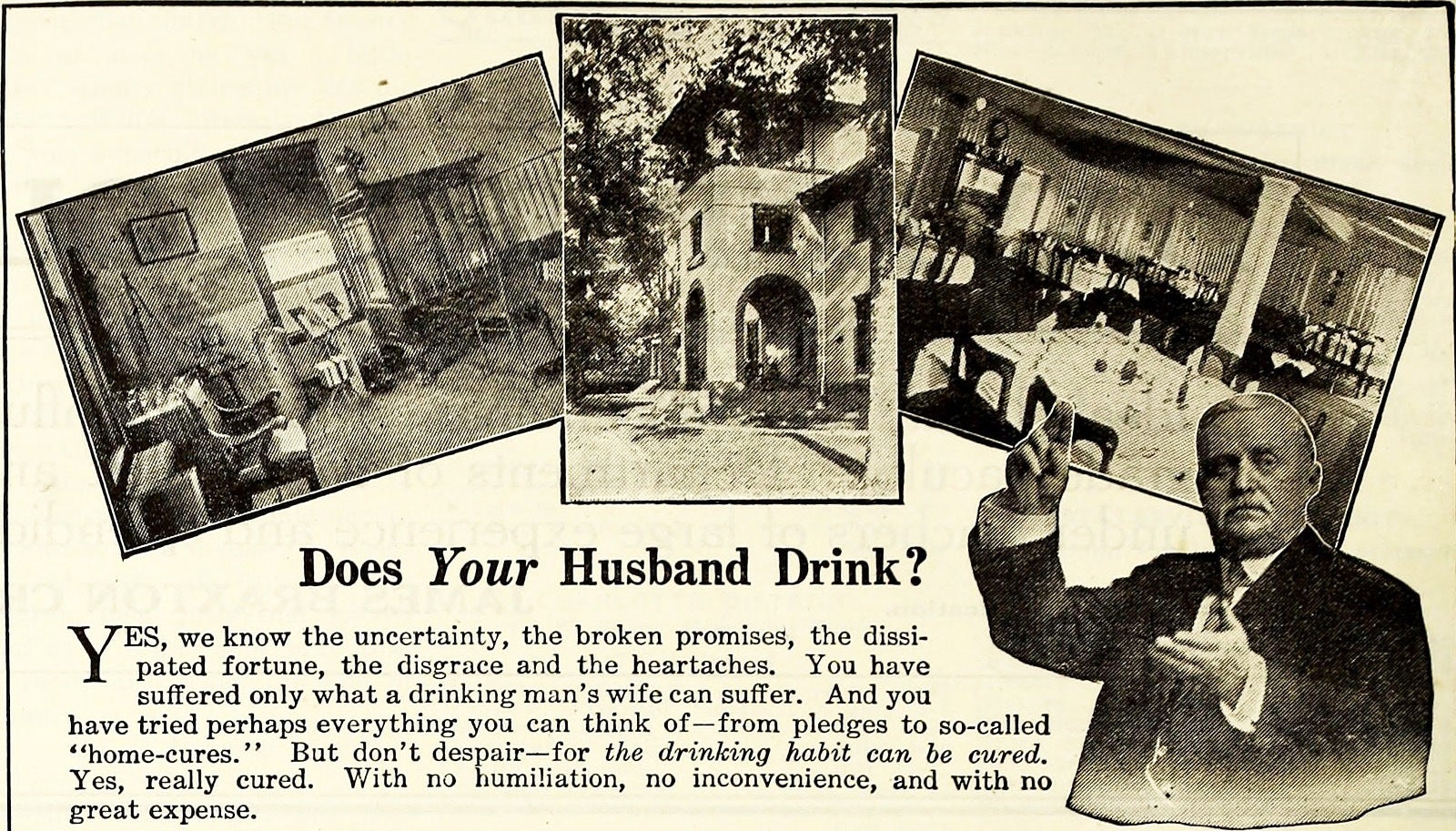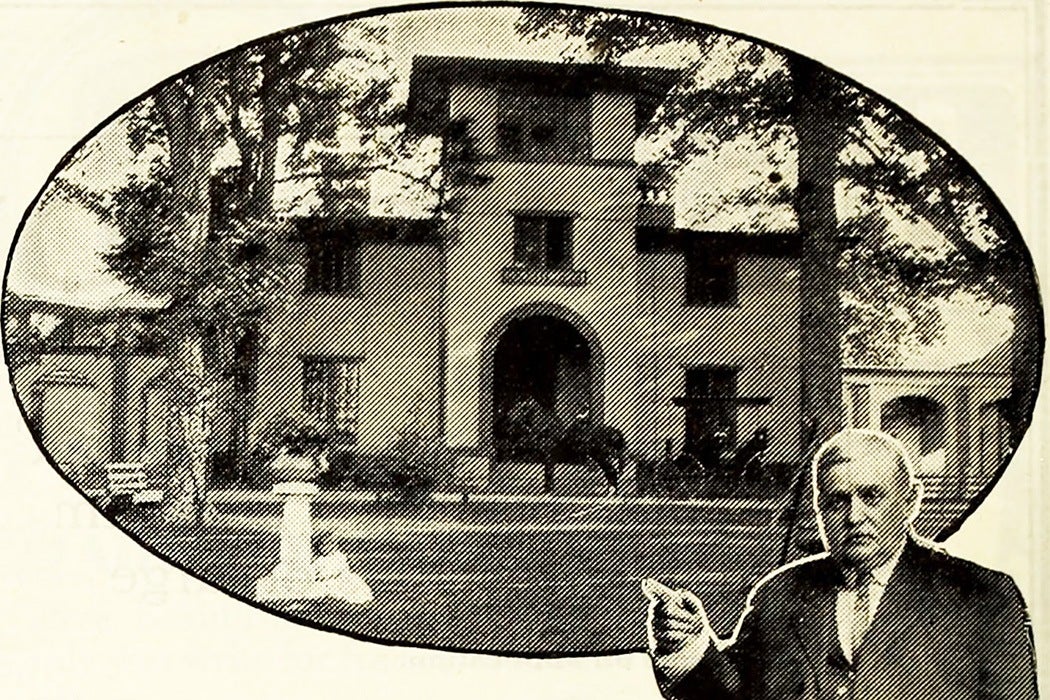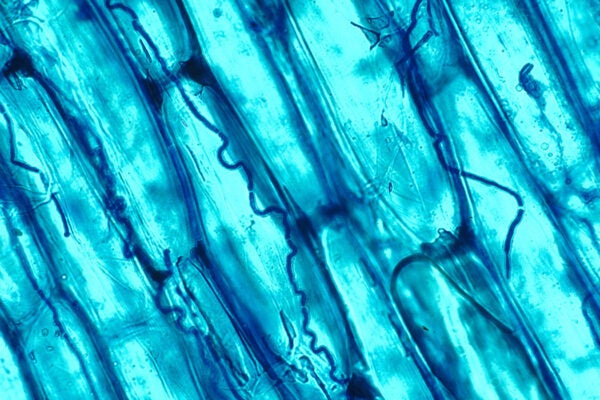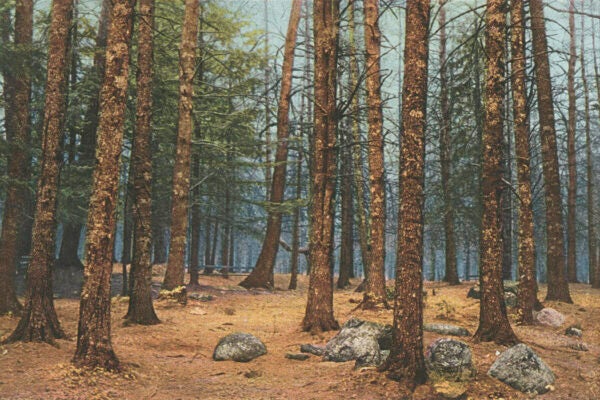Just before 8 a.m. the men began to line up. Some in waistcoats rolled their left shirtsleeves high to expose their biceps; others were dressed in three-piece suits and bow ties, a combination favored by the most fashionable of American men in 1892. Each sack coat had a surreptitious slit in the fabric of the left sleeve.
The waiting room was quiet, even as the line swelled into the hundreds. Dr. Leslie E. Keeley demanded silence. Slowly, the mostly middle-age, mostly middle-class men advanced into “the shooting gallery,” as it was known out of Keeley’s earshot, the well-appointed treatment room where they would receive four strictly regimented hypodermic injections each day—the hallmark of Keeley’s famed “bichloride of gold” cure for alcoholism.
Two physicians evaluated each man. One tended to more everyday aliments, while the other observed the patient’s eyes and, based on what he saw there, mixed a custom remedy for addiction from a mysterious array of red, blue, and white liquids. The injection was quick, the company’s breathless pamphlets promised, and painless. It left a reassuring golden stain on the upper arm.
Dr. Keeley observed the interactions, and as each patient prepared to leave the treatment room, Keeley took him by the wrist. He evaluated the man’s body temperature and his skin condition. He asked after his general health—and then he offered him a whiskey.
Weekly Digest
“I will take any liquor habitue there, soddened and saturated by twenty years of alcoholic debauch, sober him in two hours, cut short his worst spree in four hours, take him from inebriety to perfect sobriety without nervous shock or distress, and leave him antipathetic to alcoholic stimulants of every sort and kind inside of three days,” Keeley boasted of his treatment. “In the meantime, [I] will give him all the liquor he asks for; this, with the confident assurance that he will drop it of his own volition in from thirty-six to forty-eight hours. Never again will he want or desire it, though he should live a hundred years.”
“Inebriety is a disease,” he proclaimed to anyone who would listen. “I have a remedy that will cure it.”
* * *
In the United States in the late-nineteenth century, drunkenness was an epidemic. “Alcoholism is the giant evil of our age and country,” Chicago Tribune editor Joseph Medill would write in 1895. And a second plague of addiction was advancing: Opium had quickly transformed from a rare, exotic drug to a life-changing pain medication to a crippling habit, though the plight of the morphine eater was rarely as public as the drunkard’s. The temperance movement, which had waxed and waned throughout the mid-1800s, was again on the rise. Advocates preached against the vice of alcohol and encouraged strong moral character and abstinence pledges, while others reached for more dramatic options to end alcoholism and drug addiction, including asylums and even corporal punishment. Keeley offered a different answer.
The idea that addiction was not a failing of the weak-willed but a bodily disease had been proposed in the scientific community in the late 1700s, by an American physician studying “the effects of ardent spirits.” A century later, Keeley was among the first wave of doctors to popularize the view and, more importantly for his entrepreneurial ambitions, to promise a simple medical solution. He claimed that his treatment, administered correctly, would end 95 percent of addictions. (The other 5 percent, one pamphlet explained, was “made up chiefly, if not exclusively, of fools.”)

Keeley was a small-town doctor when he debuted his cure. Born near the Canadian border in New York in 1832, he studied medicine in Chicago before serving as a Union surgeon. After the war, he settled in Dwight, Illinois, a farming and coal-mining town 73 miles south of Chicago on the Chicago & Alton rail line. There, Keeley partnered with a temperance lecturer, Frederick Hargreaves, to continue the research into a cure for drunkenness he had begun in the army. “There is no difference in general terms between drunkenness or alcoholism and typhoid fever or insanity,” Keeley posited. He believed that alcohol was a poison that changed the cells of the body, causing the disease of intoxication. “The weak will, vice, moral weakness, insanity, criminality, irreligion, and all are results of, and not causes of, inebriety,” Keeley wrote.
One of the first patients to receive Keeley’s new treatment was Pat Conafry, a well-known saloon keeper in Dwight. After a few days taking a mysterious tonic, Conafry lost his taste for liquor. After a week, he couldn’t drink it at all, but soon thereafter he got, in Hargreaves’s words, “gloriously drunk” and refused any more medication. Somehow, Keeley and Hargreaves considered that experiment a success. They also tested a pill that contained gold. Of the patient who received that, Hargreaves recalled, they “came near killing the poor fellow.”
The Keeley Treatment debuted in 1880, advertised alongside other proprietary medications in newspapers and dispensed by mail. Alcoholics were encouraged to purchase four bottles of the tonic to complete the four-week treatment. A teaspoon of the medication was to be taken every two hours with a glass of water. A few months later, Keeley introduced an opium cure (as well as treatments for tobacco use and for nervous exhaustion).
Although the glowing testimonials that appeared in early ads were pure invention, Keeley’s treatments quickly became a commercial success. In 1881, 2,500 people took Keeley’s cure, and he soon opened an even more lucrative institute in Dwight to dispense the tonic, adding a three-to-four-week regimen of injections in 1886. But the medical community was not so accepting of Dr. Keeley. His zealous advertising led the Illinois State Board of Health to revoke his license to practice medicine in 1881 (the governor reinstated it a decade later; the Board of Health violated procedural rules). His miracle cure was dismissed as dangerous and potentially deadly quackery. Reported side effects of the treatment included rashes, extreme fatigue, confusion, temporary blindness, and “insanity.”
The ingredients of the cure were a closely guarded secret: Strychnine, apomorphine, willow bark, ginger, ammonia, belladonna, atropine, hyoscine, scopolamine, quinine, coca, opium, morphine, and alcohol were among the rumored components. Keeley vigorously denied the use of atropine, which was known to cause nausea if taken while drinking, or more alcohol than absolutely necessary as a preservative. Few—including Keeley’s onetime business partner Hargreaves—believed that the cure included gold, the very ingredient that made it famous. Keeley insisted there was enough “to plate a ladle.”

Among Dr. Keeley’s public critics was Chicago Tribune editor Medill, who launched an investigation into the cure about the time Keeley’s medical license was reinstated. In response, Keeley challenged Medill to send the most hopeless “sots,” “whiskey bloats,” and even “morphine fiends” he could find in all of Chicago to Dwight. Keeley promised to transform them into “gentlemen” within a month. Medill accepted and was soon forced to acknowledge that “they were all returned to me, looking as if a veritable miracle had wrought upon them. The change for the better was so great that I scarcely recognized them.” The Tribune would go on to print scores of testimonials from those who, in the increasingly popular shorthand, had “been to Dwight.”
By 1892, Keeley had expanded far beyond Dwight, with more than 100 affiliated institutes in the United States and Europe. In Dwight, his small wood-sided office was replaced by an impressive stone edifice engraved with the words “The Leslie E. Keeley Co.” In addition, he opened the Livingston Hotel next door, with 56 guest rooms for patients. Dr. Keeley now attended to some 600 people a month. He boasted of 60,000 “graduates” of his cure. Across the street from the hotel, the railroad constructed a new station with cathedral ceilings and oak wainscoting. When the train from Chicago pulled in each day, dozens of patients welcomed the newest arrivals. There were stretchers at the ready for those who were too drunk to walk.
* * *
There was not much for patients in do in Dwight beyond visit the “shooting gallery,” down tonic every two hours, and greet the train. The men—and a small number of women, who lived separately and were treated in their own rooms—were not confined to the institute, but they were expected to follow strict rules for health. They were to walk as much as possible, eat well, and bathe regularly; smoking and gambling were prohibited.
To fill the days, the men developed small rituals. Some gathered for a cup of buttermilk at Harry Lawrence’s or a glass of cold water at the well. And beginning in April, 1891, a small group met daily at a nearby blacksmith shop immediately following the 8 a.m. shot—the first Bichloride of Gold Club. By 1892, the club had grown out of the shop and into an empty church and then into the old opera house. The agenda was simple: The men shared advice and read letters from graduates about their new, sober lives. The group soon spawned clubs throughout the country. Each member proudly wore a badge on his lapel: a golden horseshoe framing a K, for Keeley.
Keeley’s nineteenth-century explanation of the effects of alcohol on the body is flawed by any modern-day assessment, and his mysterious potions were likely, at best, a placebo or, at worst, another form of poison. But his unshakable view that alcoholism was a disease and not a social vice contributed to a significant shift in attitudes toward drunkenness in the 1890s. Though it was an unintended side effect of his “gold cure,” the community that developed at Dwight may have been Keeley’s most valuable contribution to the understanding of alcoholism. It presaged the institutional structures and social support that became the gold standard for treatment.
Keeley could not claim the same influence on understanding of the opium habit. Fewer opium addicts sought Keely’s treatment and there were fewer success stories. As the drunkard was reformed in the eyes of society, the morphine eater replaced him as the falsely labelled weak-willed sinner, and in 1898, the pharmecutical industry synthesized heroin from opium. That chemical reaction had the effect of hardening public opinion against opium addicts for more than a century.







